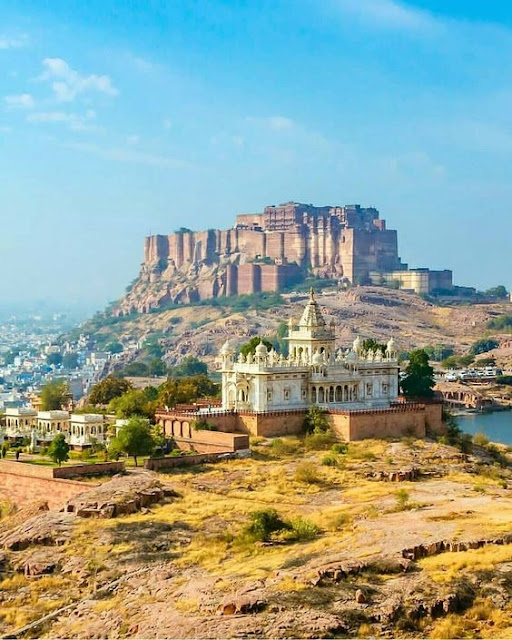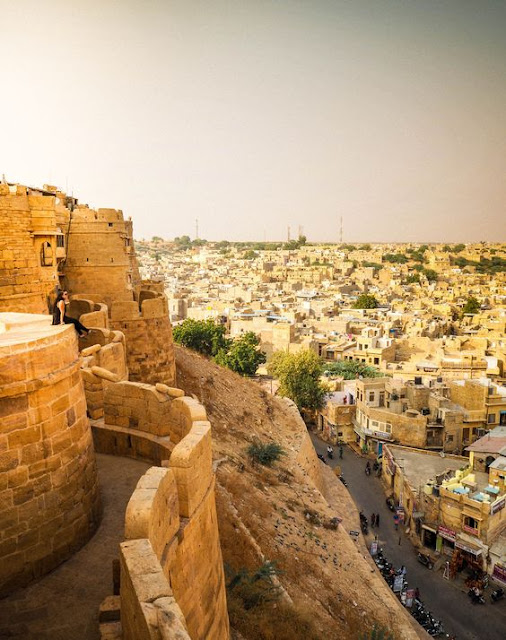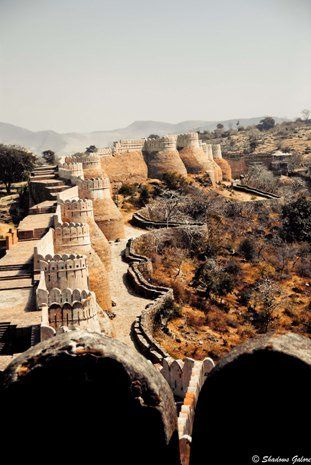jaisalmer fort history in india
Jaisalmer Fort
Jaisalmer Fort is situated in the city of Jaisalmer, in the Indian state of Rajasthan. It is believed to be one of the very few "living forts" in the world (such as Carcassonne, France), as nearly one-fourth of the old city's population still resides within the fort. For the better part of its 800-year history, the fort was the city of Jaisalmer. The first settlements outside the fort walls, to accommodate the growing population of Jaisalmer, are said to have come up in the 17th century.
Jaisalmer Fort is the second oldest fort in Rajasthan, built-in 1156 AD by the Rajput Rawal (ruler) Jaisal from whom it derives its name, and stood at the crossroads of important trade routes (including the ancient Silk Road).
The fort's massive yellow sandstone walls are a tawny lion color during the day, fading to honey-gold as the sun sets, thereby camouflaging the fort in the yellow desert. For this reason, it is also known as the Sonar Quila or Golden Fort. The fort stands amidst the sandy expanse of the great Thar Desert on Trikuta Hill. It is today located along the southern edge of the city that bears its name; its dominant hilltop location making the sprawling towers of its fortifications visible for many miles around.
In 2013, at the 37th session of the World Heritage Committee held in Phnom Penh, Cambodia, Jaisalmer Fort, along with 5 other forts of Rajasthan, was declared a UNESCO World Heritage Site under the group Hill Forts of Rajasthan.
History
A view of the fortress above the city, in the evening
Legend has it that the fort was built by Rawal Jaisal, a Bhati Rajput, in 1156 CE. The story says that it superseded an earlier construction at Lodhruva, with which Jaisal was dissatisfied. Thus, a new capital was established when Jaisal founded the city of Jaisalmer.
Around 1293-94 CE, Rawal Jethsi faced an eight to nine-year siege by Sultan Alauddin Khalji of Delhi, who is said to have been provoked by a Bhati raid on his treasure caravan. By the end of the siege, facing certain defeat, the Bhati Rajput women committed 'Jauhar', and the male warriors met their fatal end in battle with the Sultan's forces. For a few years after the successful siege, the fort remained abandoned, before being eventually reoccupied by some surviving Bhatia.
During Rawal Lunakaran's reign, around 1530 - 1551 CE, the fort was attacked by an Afghan chief Amir Ali. When it seemed to the Rawal that he was fighting a losing battle, he slaughtered his womenfolk as there was insufficient time to arrange a Jauhar. Tragically, reinforcements arrived immediately after the deed was done and the army of Jaisalmer became victorious in its defense of the fort. In 1541 CE, Rawal Lunakaran also fought the Mughal emperor Humayun when the latter attacked the fort on his way to Ajmer.
He also offered his daughter in marriage to Akbar. Mughals controlled the fort till 1762.
The fort remained under the control of Mughals until 1762 when Maharawal Mulraj took control of the fort. Due to its isolated location, the fort escaped the ravages of the Marathas. The treaty between the East India Company and Mulraj on 12 December 1818 allowed the Mulraj to retain control of the fort and provided for protection from invasion. After the death of Mulraj in 1820, his grandson Gaj Singh inherited control of the fort.
With the advent of British rule, the emergence of maritime trade and the growth of the port of Bombay led to the gradual economic decline of Jaisalmer. After independence and the Partition of India, the ancient trade route was closed, thus permanently removing the city from its former role of importance in international commerce. Nonetheless, the continued strategic importance of Jaisalmer was demonstrated during the 1965 and 1971 wars between India and Pakistan.
Even though the town of Jaisalmer no longer serves as an important trading city, or as a major military post, the town is still able to earn revenues as a major tourist destination. Initially, the entire population of Jaisalmer lived within the fort, and today the old fort still retains a resident population of about 4,000 people who are largely descended from the Brahmin and Rajput communities. These two communities once served as the workforce for the fort's one time Bhati rulers, which service then entitled the workers to reside on the hilltop and within the walls of the fort.[4] With the slow increase in the area's population, many of the town's residents gradually relocated to the foot of the Trikuta Hill. From there the town's population has since largely spread out well beyond the old walls of the fort, and into the adjacent valley below.
Architecture
The fort is 1,500 ft (460 m) long and 750 ft (230 m) wide and is built on a hill that rises above a height of 250 ft (76 m) above the surrounding countryside. The base of the fort has a 15 ft (4.6 m) tall wall forming the fort's outermost ring, within its triple ringed defense architecture. The fort's upper bastions or towers form a defensive inner-wall perimeter that is about 2.5 mi (4.0 km) long. The fort now incorporates 99 bastions, of which 92 were built or substantially rebuilt between the period of 1633-47. The fort also has four fortified entrances or gates from the downside, one of which was once guarded by cannon. Other points of interest within the fort's walls and grounds include
Four massive gateways through which visitors to the fort must pass, situated along with the main approach to the citadel.
The Taj Mahal Palace, former residence of the Maharawal of Jaisalmer.
Jain Temples: Inside Jaisalmer Fort, there are 7 Jain temples built by yellow sandstone during the 12-16th century. Askari Chopra of built a huge temple dedicated to Sambhavanatha. The temple has more than 600 idols with many old scriptures. Chopra Panchaji built the Ashtapadh temple inside the fort.
The Laxminath temple of Jaisalmer, dedicated to the worship of the gods Lakshmi and Vishnu.
Numerous Merchant Havelis. These are large houses often built by wealthy merchants in Rajasthani towns and cities in North India, with ornate sandstone carvings. Some Havelis are many hundreds of years old. In Jaisalmer, there are many elaborate Havelis carved from yellow sandstone. Some of these have many floors and countless rooms, with decorated windows, archways, doors and balconies. Some Havelis are today museums but most in Jaisalmer are still lived in by the families that built them. Among these is the Vyas Haveli which was built in the 15th century, which is still occupied by the descendants of the original builders. Another example is the Shree Nath Palace which was once inhabited by the prime minister of Jaisalmer. Some of the doors and ceilings are notable examples of old carved wood from many hundreds of years ago.
The fort has an ingenious drainage system called the which allows for the easy drainage of rainwater away from the fort in all four directions of the fort. Over the years, haphazard construction activities and the building of new roads have greatly reduced its effectiveness.
The fort has numerous eateries, including Italian, French and native cuisines. The famous Indian film director Satyajit Ray wrote the Sonar Kella (The Golden Fortress), a detective novel, based on the fort and he later filmed it here. The film became a classic and a large number of tourists from Bengal and around the world visit the fort annually to experience for themselves the world that Ray portrayed in the movie. Six forts of Rajasthan, namely, Amber Fort, Chittor Fort, Gagron Fort, Jaisalmer Fort, Kumbhalgarh, and Ranthambore Fort were included in the UNESCO World Heritage Site list during the 37th meeting of the World Heritage Committee in Phnom Penh during June 2013. They were recognized as a serial cultural property and examples of Rajput military hill architecture.
Restoration
Jaisalmer Fort (from Sonargadh)
The Jaisalmer Fort today faces manifold threats that are a result of the increasing population pressure on it. Water seepage, inadequate civic amenities, derelict houses and seismic activity around the Trikuta Hill are some of the major concerns impacting the Fort. Unlike most other forts, the Jaisalmer Fort has been built over a weak sedimentary rock foothill which makes its foundations especially vulnerable to seepage. Over the years this has led to the collapse of significant portions of the Fort such as the Queen's Palace or Rani Ka Mahal and parts of the outer boundary wall and the lower pitching walls.
The World Monuments Fund included the Fort in its 1996 World Monuments Watch and again in the 1998 and 2000 reports due to the threats posed to it by an increase in its resident population and the increasing numbers of tourists who visit it every year. The Fort is one of Rajasthan's most popular tourist attractions with as many as five to six hundred thousand tourists visiting it annually. As a result, it is abuzz with commercial activities and has seen phenomenal growth in both human and vehicular traffic.
Major restoration work has been undertaken by the World Monuments Fund and UK based charity Jaisalmer in Jeopardy. According to former INTACH chairman S.K. Misra, American Express has provided more than $1 million for the conservation of Jaisalmer Fort. The absence of coordinated action among the various government departments responsible for civic amenities, the local municipality and the Archaeological Survey that is responsible for the upkeep of the fort is a major impediment in its maintenance and restoration.





Comments